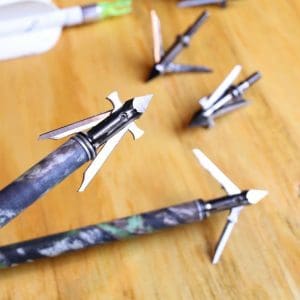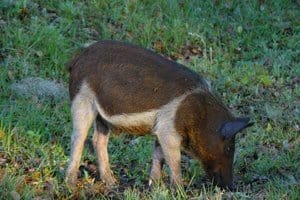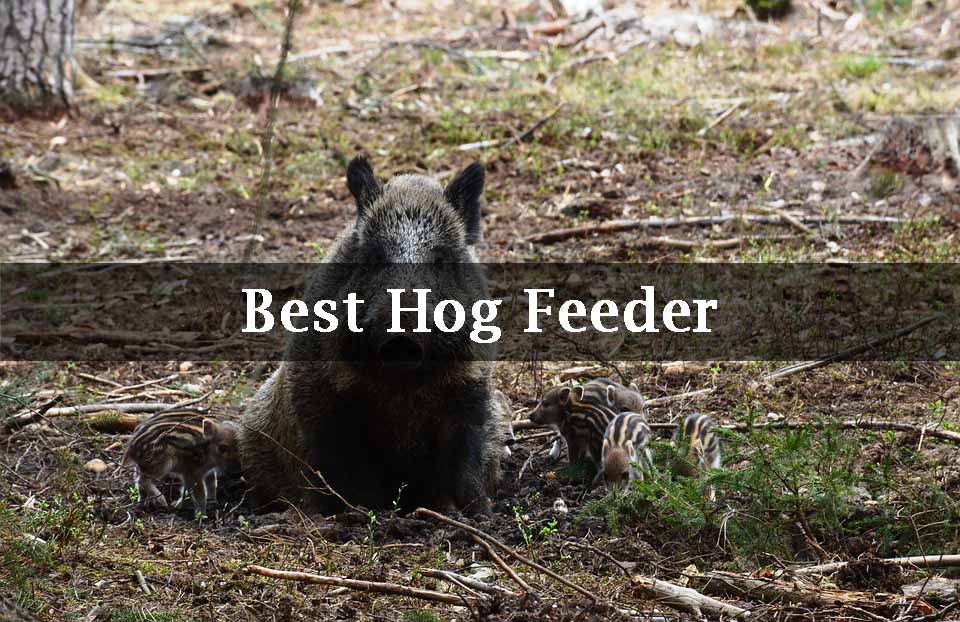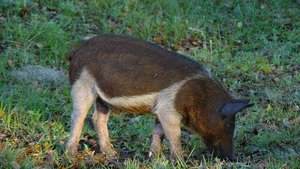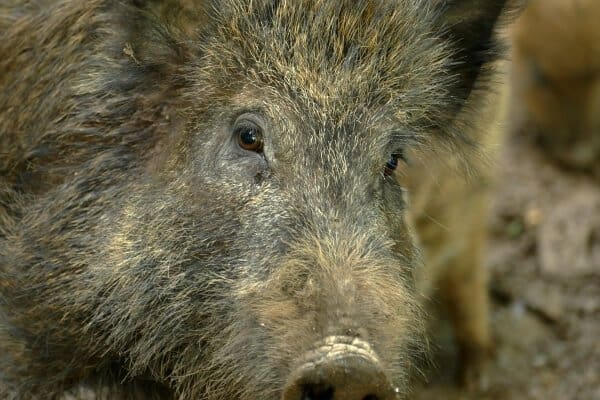Hog Hunting 101: Ultimate 2021 Beginner’s Guide

Wild hogs are quickly becoming one of the most popular animals to hunt. The feral populations in many states are so out of control that there are relatively few restrictions when it comes to hunting them on private property, and some states don’t even regulate hunting them in public spaces anymore.
On top of that, they also make a great quarry because they have a massive amount of usable meat to eat. With pork being much more popular then venison in diets, it’s a fantastic catch for avid sportsmen who like to eat. They also make some very impressive centerpieces to backyard luaus if you want to show off your skill!
If you like the idea of hunting but not the idea of killing, hogs are a good option. Because their population is so out of control, you are actually doing a favor to nature by helping to cull the population. They reproduce as rapidly as bunnies and they can completely decimate crops and property in a matter of minutes thanks to their rooting, running, and mudding. Landowners consider it a favor if you take down some hogs, and so do the forests, crops, and other animals. Hogs threaten the safety of other animals – both domesticated and wild.
Hog Hunting Guide - Need to Knows about Hog Hunting

Before we get into the logistics and legalities, let’s cover some basics when it comes to hunting hogs. These guidelines will help you learn the ins and outs when it comes to hunting these feral creatures and bringing home the bacon… literally.
Hunting Method
There are a lot of ways to hunt hogs so you need to pick the one that works best with your natural style. Start by looking into the legal ways to hunt in your area and work from there to plan your trip.
Know Your Territory
This is a major piece of information that should seem obvious to any seasoned hunter, but is often overlooked. Know your area. You need to be familiar with the legislative regulations in the area, lines between private and public property, how traveled it is and who comes through, whether it is other hunters or day hikers.
You also need to know what sort of local wildlife is in the area along with the hogs, where the water sources are that will make the most likely mudding areas, the ins and outs of the terrain and how to find your way around in the dark as well as the daylight.
Hogs are Nocturnal
Hunt at night. Hogs have adapted to being hunted, and don’t come out during the day very often. For this reason, one of the most important things to know about hog hunting is that you will have much more success if you hunt at night instead.
The warning I will give is to know your territory well. Things look different in the dark, and it can be harder to see pits and brambles or distinguishing landmarks. You could easily twist an ankle or get lost in the dark if you don’t know the area well.
You can also bring reflective gear and lighting to help you see in the dark and also to help other hunters see you!
Tracking
You also need to know what you’re looking for when it comes to hog hunting. You can’t kill a hog if you don’t know how to find a hog. Here are some ways to find them.
Rooting: Hogs root for food with their snouts. Uprooted soil is a really easy way to tell whether a hog has been through or not. The darker the rooting, the more recent a hog has been through the area.
Tracks: It is important to know how to distinguish between deer and hog tracks, so you don’t end up following the wrong trails. Deer tracks are pointier, whereas hog tracks are more rounded. Hogs also leave a wider track than deer. Hogs will also step into their own tracks a lot, whereas deer rarely tread over their own tracks.
Wallowing: Hogs like to dig near water sources to cool themselves down. They will make mud baths for themselves and roll around in them. If you noticed a patch of really muddy land, that’s probably a hog wallow. Clear water in the hollow indicates an abandoned area, whereas cloudy and dirty water means it is likely still active and hogs are nearby.
You can catch quite a few hogs by setting up a shot in a clearing between wallows that has a lot of cover for you. Hogs will travel between wallows a few times a day, leaving them exposed to your shots.
Rubbing Poles: These are great resources to use for hog hunting. They will let you know where hogs cross through a given area and how big they are. Look for trees with lots of mud at the base or scrapes and missing chunks from tusks. If you see cut marks on a rubbing tree then you have found yourself a big trophy.
Excrement: Hog poop tends to look like boulders or pebbles. The greyer the poop, the older it is. If you come across an area with a lot of brown and very smelly leavings then you have likely stumbled across a major feeding area and should set up nearby.
Scents, Calls, and Baits
You want to eliminate your scent or hogs will avoid you. A good way to mask it is by using urine scents to attract male hogs and molasses and berry scents to attract hungry ones.
You can also purchase hog calls from hunting stores. Hearing their own kind will draw them closer and make them curious. Hogs have excellent hearing, so make sure that you stay as still and quiet as possible or you will scare them away.
If you found a spot with great cover for your blinds, and want them to come to you, dig a deep and narrow hole and drop in some food. They’ll smell it and come for it but they will also have to spend a lot of time rooting it out with their nose since it’s so far down. This means they’ll spend a while lingering in the same spot so you can target them easier.
Legalities of Hog Hunting in the U.S.

Hog hunting is pretty easy to accomplish in the US. Feral hog populations have gotten so out of control that there are far fewer regulations on hog hunting than other types of game. Many states don’t even regulate how many you can bag at a time. Very few of them restrict hunting seasonally, and hunting permits are as low as $25 in most states. In fact, many states don’t even require residency to get paperwork for cheap.
On top of that, almost all of those restrictions do not apply to hunting on privately owned land. Because feral hogs do so much damage to property and crops, landowners are more than happy to allow you to hunt on their land. In some states, like Oklahoma, they may even call you and beg you to come out without charging you to do so!
Make sure that you look into individual state and county permits and regulations, because they vary from state to state and county to county. Presently, Oklahoma and Texas have the most hunter friendly laws for hog hunters, with Texas imposing almost no legislation at all aside from daytime orange requirements.
A good place to start is the US Fish and Wildlife Service. They will be able to direct you to the right state agency to obtain your permits and regulations from in each state.
You can also reach out to individual property owners who run game hunting tours, like the Tejon Ranch in California. They will be very familiar with the regulations and requirements in their state of operation and can let you know what you will need to hunt on public property or private.
Best Locations for Hog Hunting
These are some great locations for hog hunting. These are the top 5 areas where hunting is good along with some of the best regions therein.
California
While California doesn’t make the list of the best places to hunt for experienced hunters, I have included it as the first spot in our beginner’s guide because it is a fabulous place to learn. They don’t have a lot of hunting available on public land and I wouldn’t recommend trying, but they have tons of private outfitters who have opened their properties.
California hunting is where beginners can dip their toes in and decide whether they want to start this sport or not. You can get fully guided hunts on large areas of land where your guides will take you to the best spots and show you how to track and hunt these hogs.
Once you get used to that, you can scale back to semi-guided hunts. These ones will not hold your hand quite as much. You’ll get pointed in the right direction. The upside to these places is that you’re pretty much guaranteed good hunting grounds. They’ve made sure that they welcome the hogs to their land so that they’re stocked and ready to go when hunters come through on trips.
One of the best spots is the Tejon Ranch, which has over 270,000 acres of privately owned ranch that is opened to hunters at pretty affordable rates. Camp 5 Outfitters is another great property. They’re much smaller, at only 60,000 acres, but they offer multiple day hunts and lodging right on property.
Once you’ve learned the ropes at these private, guided hunting spots you can graduate to the public hunting areas, which don’t have the same fees that private places do but will leave you on your own to hunt.
Texas
Texas is one of the best places to hunt hogs. Estimates show that nearly half the wild hog population in the USA is found in Texas. The feral population there is so out of control that at present they have almost no regulations on when you can kill or how many you can bag. Many landowners are willing to issue you their written consent for you to hunt on their property, too, because it helps them keep their crops protected against hog rooting.
A Texas town called Sabinal calls itself the “Wild Hog Capital of the World” and hosts an annual festival. They’re a great farming community near the Hill Country that may be willing to help new hunters learn the ropes.
Florida
Florida has almost as many wild hogs as Texas. In Florida, landowners are less likely to allow you to hunt on their property, but public land is game. This state has more regulations than Texas, so be sure that you know their regulations and have your permits before hunting there. The best place for information is to contact the Florida Fish and Wildlife Conservation Commission.
The best places in Florida are the Lower Ecofina River, Kicco, and Myakka State Forest. A lot of hunters also enjoy the Apalachicola area. That being said, these are also the most well known areas, so you are likely to run into far more hunters here. While that’s a good thing if you want to make friends and have someone show you the ropes, it will also mean more competition for the best game and less likelihood that the best spots haven’t already been taken.
Do some research and find a place you love that has the right balance between people and game. You want to look for WMAs (Wildlife Management Areas) that have hogs.
The Southeast
I am going to mention the Southeast as a collective because it has tons and tons of big game hunting and hunters. You can find great hog hunting in nearly every state, and if you carry a license for a few bordering states, then you don’t have to pull back when your woods cross state lines.
Georgia is fantastic for hog hunting. Private land owners will let you hunt all year round and the state does not set limits on how many hogs you can hunt. They also allow you to hunt at night. You are allowed to hunt in the evenings with any firearm or archery you choose if landowners give you permission to hunt. You can chase hogs across properties, and there are tons and tons of wildlife management areas that welcome safe hunting practices.
Fort Stewart welcomes hunters year round, with no limit on how many you can bag. The only time they close is the spring turkey season. The land has over 250,000 acres full of “piney woods rooters” that swarm the area. Hogs run rampant across all 250,000 acres, but for especially easy bags try the 90,000 acres of wet lands. You must purchase a pass and permit but they have an automated access system so you can stake out the areas you are hunting for the day with your touch-tone phone. This is a great way to ensure that hunters are spread out and not taking over each other’s areas.
Most of the hunting will be in the southern part of the state, near the Chattahoochee, Flint, and Oconee river basins. There are private holdings at Okefenokee National Wildlife Refuge that will let you cross hogs across state lines.
Alabama has 17 areas that support wild hog hunts. Look to the southwest side of the state, in the Upper Delta and Mobile-Tensaw Delta areas. The northern part of the state is also a great option, with Freedom Hills, Black Warrior, and Seven Mile Island WMAs providing great locations.
Russian boars run wild in Tennessee. All but 15 of their counties currently have a population problem with wild hogs. They keep to the swamps and the bottomlands near Mississippi, Reelfoot Lake, and the Tennessee River Valley. Farmers are allowed to kill hogs on their property, and those legislations allow them to ask hunters for help. This means that you can often find willing landowners who will grant you hunting rights on their property here.
Other southern states hospitable to boar hunting include Mississippi, Louisiana, and North Carolina.
The Midwest
As you move over to the west coast, hog hunting becomes a bit sparser. Still, there are some great options for hunters who don’t want to travel too far from coast to coast. In fact, it is another really great hunting option.
Most game hunters think about trophy bucks when they think about Missouri, but it actually hosts some fantastic hog hunting, too. You don’t need a permit to hunt unless it’s deer or turkey season and a lot of the state as hogs. When it comes to the best hunting though, the southern part of the state is best. The active hog populations like sticking to the waterways in the Devil’s and Ozarks Backbone WMAs.
Oklahoma hosts wild hogs in every single county. License requirements vary in the state, so be sure to check county as well as state regulations before hunting here. The Eagle and Glover Fork rivers covered by the Honobia-Three Rivers WMA, and it’s got almost 1 million acres of land. In Oklahoma, you still need a license to hunt on private land during the big game season, so don’t forget your paperwork. You will want to call them anyway, because their hog problem is so massive that they keep a directory of hunters and call you o come out if landowners need some help. In fact, while most private property hunting will cost you some money, in Oklahoma, landowners may actually pay you!
Must Have Hog Hunting Pack List
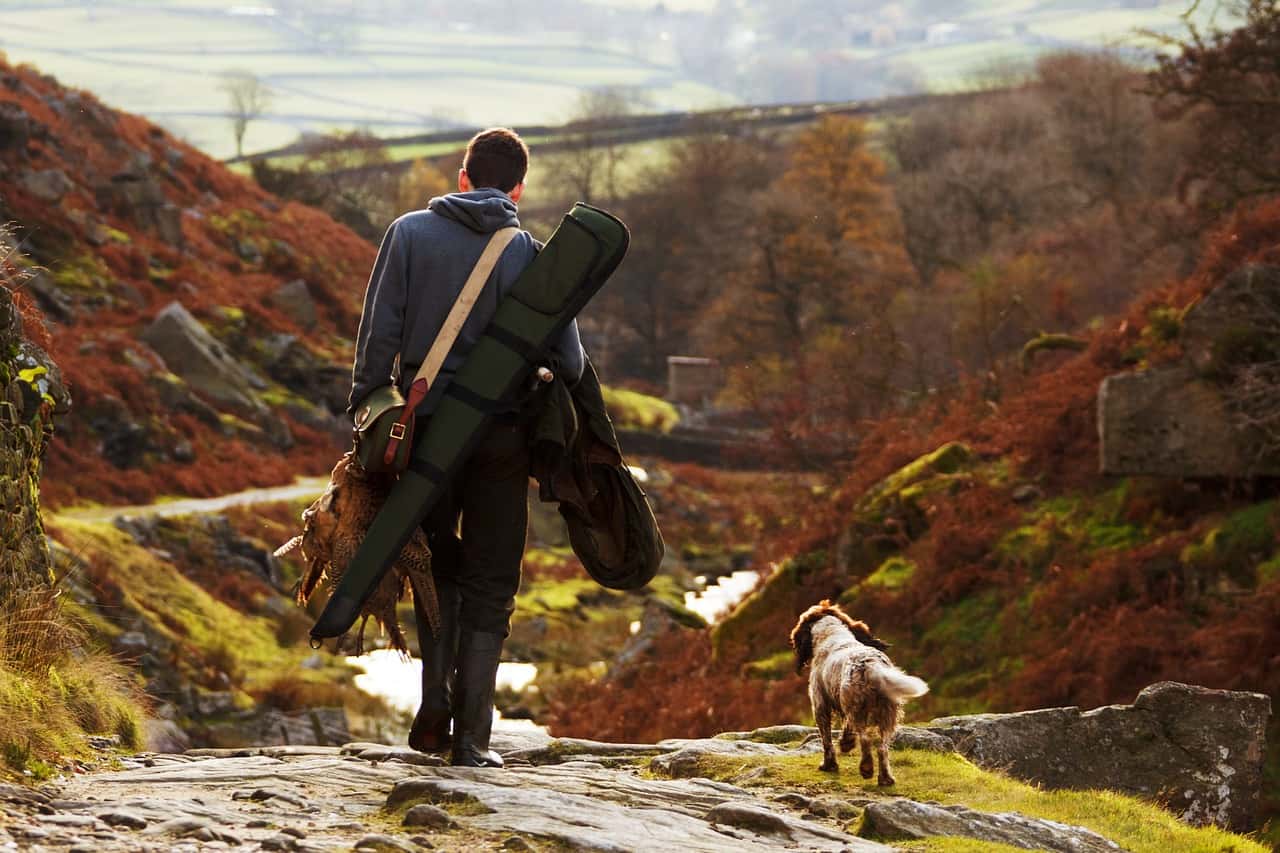
Just like any vacation, packing for a hunting expedition takes some planning. Here are a few things that are crucial to your hunting trip. You must pack them to be successful.
Licenses and Paperwork
Different states have different regulations when it comes to hog hunting, but you always want to be legal. Make sure you take care of necessary paperwork and keep it on you at all times in case you need to show proof.
This includes relevant hunting licenses and permits as well as certified proof of the land owner’s permission to hunt on privately owned property if you have obtained this permission. If not, make sure you do before hunting on private property.
Hunting licenses can be purchased for very little money; often as low as $25, and once obtained allow you to hunt on any public property freely during their approved hunting seasons.
Clothes for Hunting
You have to dress for the weather during your hunt but also for the woods. Make sure to wear proper clothing. First and foremost, know that whatever you wear will get dirty, possibly torn, very smelly, and more than likely irreparably damaged or soiled, so don’t wear anything that you plan to wear outside of hunting.
You should wear hunting pants that are made with materials that can hold up to woody conditions. Canvas is a great option. If you are more comfortable in jeans, then wear some chaps or brush pants over them. You will want to wear boots as well.
Depending on the time of year, you may want to invest in insulated jackets and gloves or rain gear made for mud and downpours.
All of your clothes should be camo or dark colored to blend into the woods and avoid detection, but you may need to check state laws for orange requirements. A lot of states have regulations. For example, Texas may be extremely laid back when it comes to hog hunting regulations and seasons, but they insist that anyone hunting during the day time with firearms needs to wear a certain amount of bright orange material and orange headgear so that other people in the area can see them and avoid their area.
Toilet Paper
So many people forget this, but trust me you will want it. There’s nothing worse than being stuck without when you have to go and leaves are definitely not ideal. Don’t end up ripping off parts of your clothes because you forgot to pack this essential! Also, if you plan to be in rainy weather, make sure you seal it or you just end up with a soggy, useless mess.
Ammunition
Most hog hunters are going to use a rifle instead of a knife. No matter which rifle you prefer, Remington or Marlin or otherwise, you can’t leave it behind. I recommend using a .243 or better to have enough stopping power for a hog. You will also want to be able to fire off more than 1 shot before the hog disappears unless you are a sharp shooter with perfect accuracy who is familiar with the vital areas on a hog.
You will also want to bring the right ammo for your gun. Remember that hogs have very thick skin and their bones are pretty dense, so you need strong enough bullets to penetrate. Barnes, Noslet, Swift, and Hornady offer some great hunting bullets.
Survival Equipment

This is a broad list of things that you may not necessarily need for hunting but will be extremely helpful in the wilderness. You never know when you might get caught unawares by a force of nature or unexpected circumstance, and being prepared is critical.
Bring a hunting knife. While hog hunters rarely hunt with these because of how difficult targeting can be, it is still critical to have to deal with difficult brush, snares, finishing the job when you’ve taken a hog down, and more.
Water and food is also important. You are often carrying gear and ammo through the woods, when it is very hot outside. It can be easy to become quickly dehydrated if you do not bring enough. You should always bring a bit more food and water than you need in case you get stuck and can’t make your way back as quickly as anticipated.
Bring a first aid kit, too. You never know when you may need emergency care, and being injured in the woods by yourself will mean you need to have ways to keep your wounds clean until you can get yourself back to safety.
Have a flashlight and two-way radio and some backup batteries. You never know when you will need to call for help. Flashlights are great tools. They’re heavy enough to be good defense systems. The lights can signal others of your presence, and they can help you track in the dark.
Conclusion
I hope this guide has given you a lot to think about when it comes to hunting hogs. Last tip: make sure to know where to target. Hog's vital organs are in different places than other games, so you will need to be very precise with your targeting in order to kill them. Know where to aim. Happy hunting!

